
BUILDING BY BUILDING
A TALE TOLD IN WALLS, VISION AND GRIT.
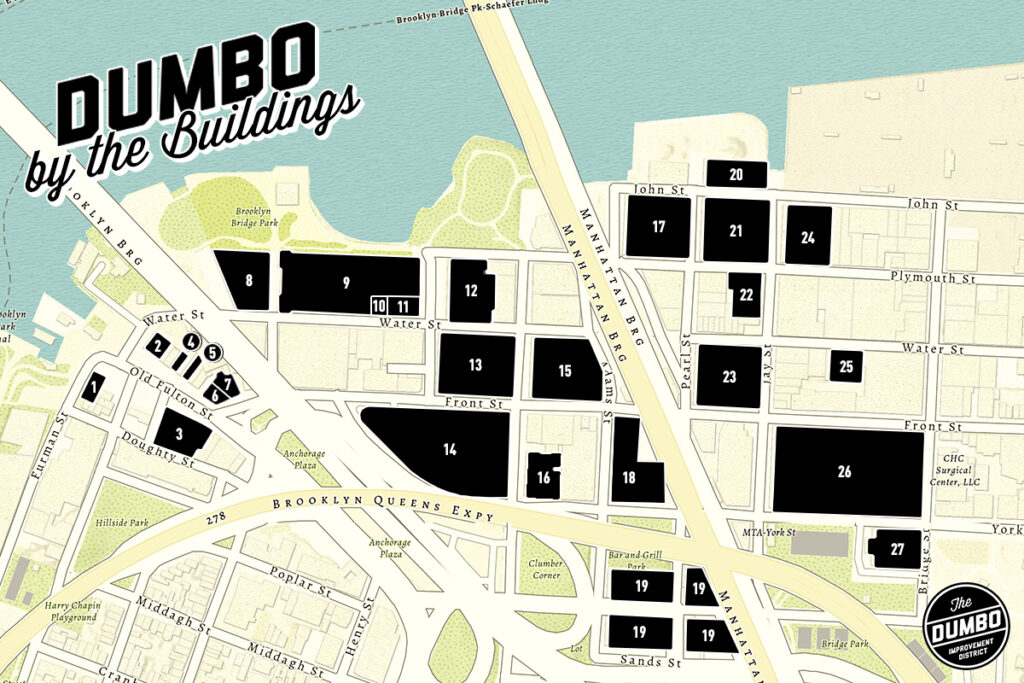
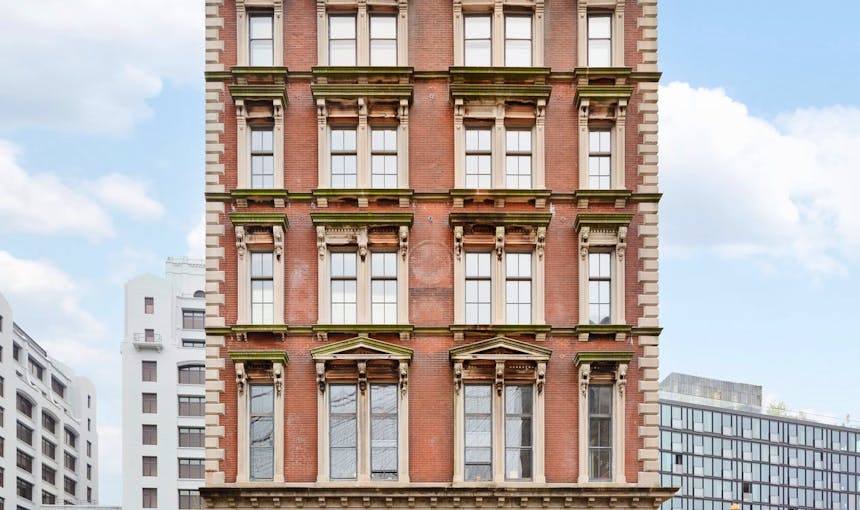
[1] 8 OLD FULTON STREET
Year built: 1860-61
Original Owner: Brooklyn City Railroad Company Building
Original purpose: Office
Adaptive reuse: Apartments
8 Old Fulton Street was originally built as the headquarters for the Brooklyn City Railroad. Its location was key — the Brooklyn City Railroad ran along Fulton Street, connecting the Fulton Ferry terminal to interior parts of Brooklyn, including newly developing areas such as Park Slope With the opening of the Brooklyn Bridge, Fulton Landing faded in importance and 8 Fulton Street was adapted for light manufacturing and later converted to apartments.
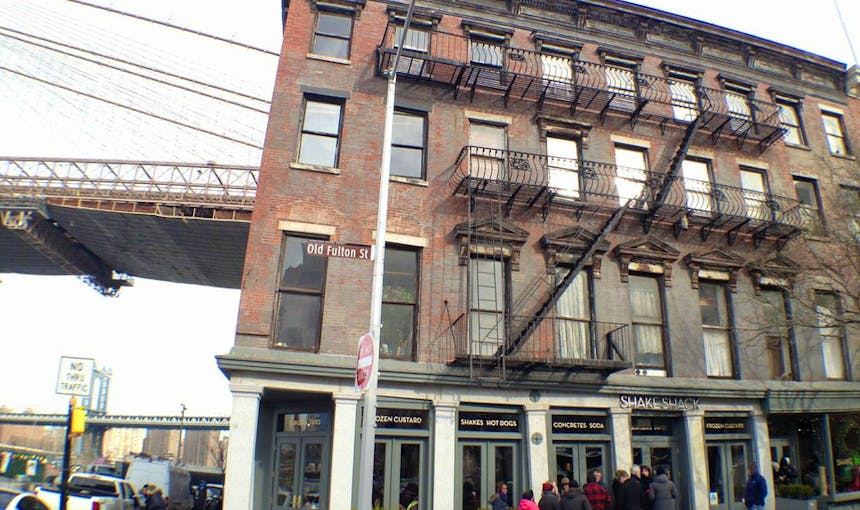
[2] 1 OLD FULTON STREET
Address: 1 Old FultonYear built: 1835
Original purpose: Hotel
Adaptive reuse: Restaurant
Notable uses/Companies today: Shake Shack
Named for Robert Fulton, inventor of the steamboat, Fulton Street was a critical hub in Brooklyn’s early days, stretching from the harbor to Jamaica, and connecting Manhattan to merchants and farmers deep into Brooklyn. And–those merchants, farmers, seamen, clerks and visitors found places to eat, drink and sleep along what is now Old Fulton Plaza. Anchoring this row of buildings was 1 Old Fulton – The Franklin House Hotel.
“This hotel was one of the most important such hotel establishments of the 19th century
In addition to serving its customers the ballroom upstairs used to double as a site for Quaker services.
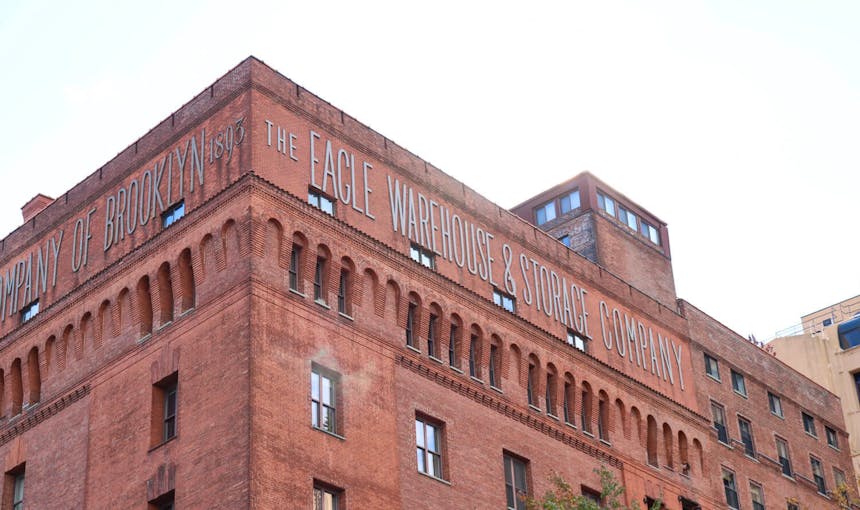
[3] 28 OLD FULTON STREET
Year built: 1893
Architect: Frank Freeman
Original purpose: Warehouse
Adaptive reuse: Brooklyn Law School, and now co-op apartments
28 Old Fulton was built on the site of the old Brooklyn Eagle building, the headquarter of Brooklyn’s venerable newspaper, and was, therefore, named after this establishment. “The building could have easily been just another warehouse in a district of utilitarian warehouses, but Frank Freeman, one of Brooklyn’s best architects, chose to make it unique…Freeman has designed a building that entices us to keep looking”, says Suzanne Spellen in a Brownstoner post on 28 Old Fulton. The beautiful architecture and highly visible signage successfully have attracted travelers. Between 1904 and 1928, it was the home of the Brooklyn Law School, and in 1980, it was converted into condominiums and has remained its residential purpose ever since.
Learn more about the architecture of 28 Old Fulton in this Brownstoner post.

1908 advertisement via Brooklyn Daily Eagle Almanac
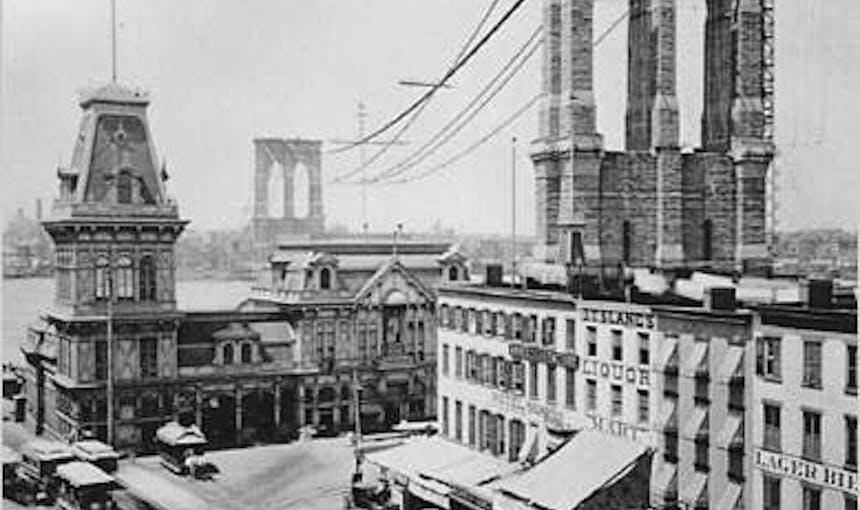
[4 & 5] 11 & 15 OLD FULTON STREET
The Franklin House Hotel was in good company. According to this article in the New York Times, in the early 1800s: “…No. 5 Old Fulton was a tobacco warehouse, and at No. 11, Robert R. Story made saddles, harnesses and engine hoses. At No. 15, Valentine, Bergen & Company operated a wholesale grocery, which sold a fruit vinegar with a maiden on the label declaring, “I am soulfully intense.”…Richard Hathaway, a sailmaker, worked in No. 21, and there were several cork dealers in No. 23. In 1869, the Long Island Safe Deposit Company built its ornate cast-iron bank building at the upper end of the block at No. 25, in a tiny little palazzo designed by William Mundell.”

[6] 1 FRONT STREET
Year built: 1868-69
Architect: William A. Mundell
Original purpose: Safe Deposit bank
Adaptive reuse: Commercial Space
Notable uses/Companies today: Grimaldi’s
When architect William Mundell designed this beautiful Venetian-inspired palazzo, cast iron was still a new construction material in Brooklyn. Covering the entire façade and the inside, cast iron provided the much needed fireproofing protection for its owners, the Long Island Safe Deposit Company and the Brooklyn Bank. The Brooklyn Bridge’s diversion of commuting traffic after 1883 forced the bank to close its door in 1891. 1 Front Street then became a warehouse and was ill-cared for many years. It was not until the late 2000s that this building was brought back to life. Today, it is the focal point of the street with its bright white coat and is home to the famous Grimaldi’s Pizzeria.
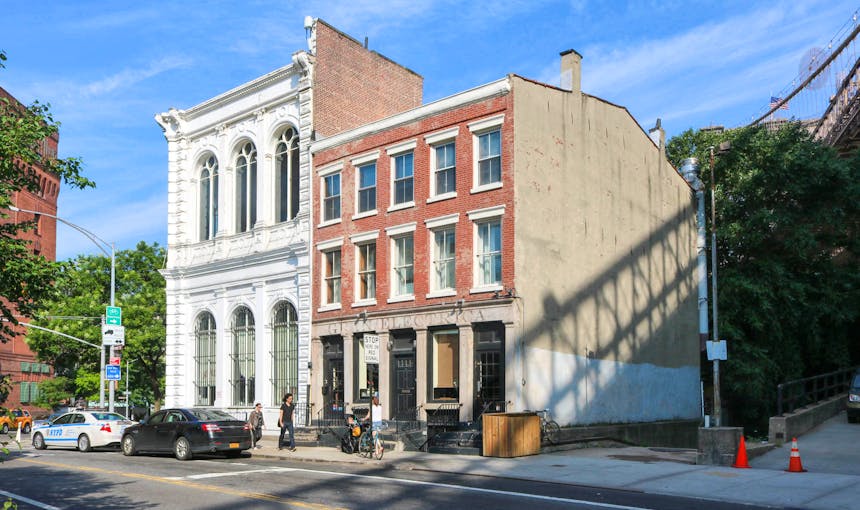
[7] 5-7 FRONT STREET
Year Built: 1834
Original Purpose: Office Building
Adaptive reuse: Commercial + Residential
Notable uses/Companies today: Gran Eléctrica
5-7 Front Street is believed to be the oldest office building in all of New York City. While the exact date of construction is unknown, from 1834, it was headquarters for the Long Island Insurance Company, which sold fire insurance. Rumor has it that the first meeting to plan the building of the Brooklyn Bridge was held here!
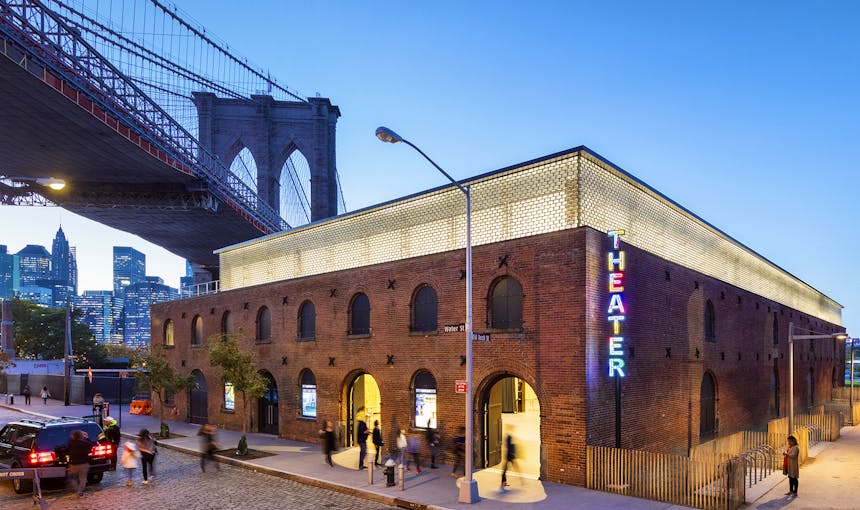
[8] 45 WATER STREET – ST. ANN’S WAREHOUSE
Year Built: 1870
Original purpose: Inspection center for tobacco
Adaptive Reuse: Theater
The famous St. Ann’s Warehouse was originally constructed as a 5-story brick and timber rectangular tobacco inspection center and warehouse during the Civil War period. With the construction of New Dock Street in the early 20th century, the southern end of the warehouse was truncated, creating the current trapezoidal structure. Later in the 20th century, the building’s height was reduced to two stories. In its lifetime, the building was saved from demolition twice, once in the ’60s and once in the ’90s. 45 Water St, now a city landmark, houses avant-garde theater group St. Ann’s Warehouse with a large, versatile theater space, a multi-use artists’ studio, and the Max Family Garden.
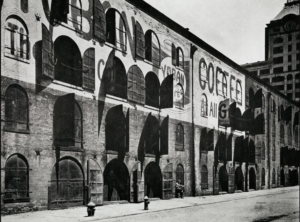
[9] 53-83 WATER STREET – EMPIRE STORES
Year Built: Western warehouses in 1870; Eastern warehouses in 1885
Architect: Western end: Manhattan-based firm Nesmith & Sons; eastern end: Thomas Stone
Original Purpose: A storage warehouse for coffee industry pioneer Arbuckle Bros.
Adaptive reuse: Mixed-use of restaurant, retail, office, and event spaces
Notable uses/Companies today: West Elm, Timeout Market
The Empire Stores are actually seven brick warehouses that were built in two sections, one fifteen years after the other. Originally used to warehouse raw materials such as coffee beans, animal hides, raw sugar and molasses that were brought in on ships from Africa, Cuba and South America, this 151-year-old complex, according the Landmarks designation report, bears “mute testimony to the prosperous commercial activity of Brooklyn during the second half of the 19th century”. Learn more about the history of Empire Stores in this Brownstoner post.

Empire Stores in 1936
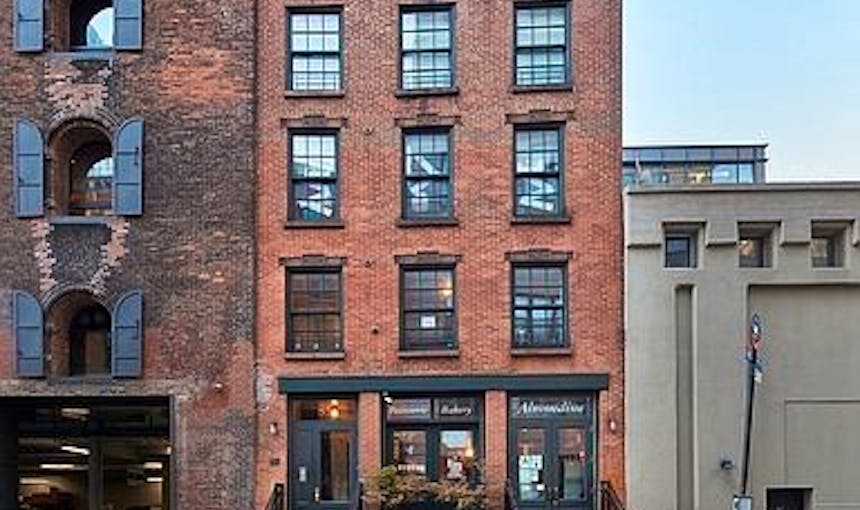
[10] 85 WATER STREET
Year built: soon after 1835
Original purpose: Private House
Adaptive reuse: Commercial space, and then rented for both commercial and residential
Notable uses/Companies today: Almondine
As one of the oldest buildings in DUMBO, 85 Water Street has a history that was not without ups and downs: from a private home, it was converted to a pepper factory and used for industrial purposes for 70 years. It was later abandoned for about 50 years until chosen as a rehab project for Bob Vila’s Home Again show. 85 Water Street has since been the home to Almondine, a well-beloved bakery.
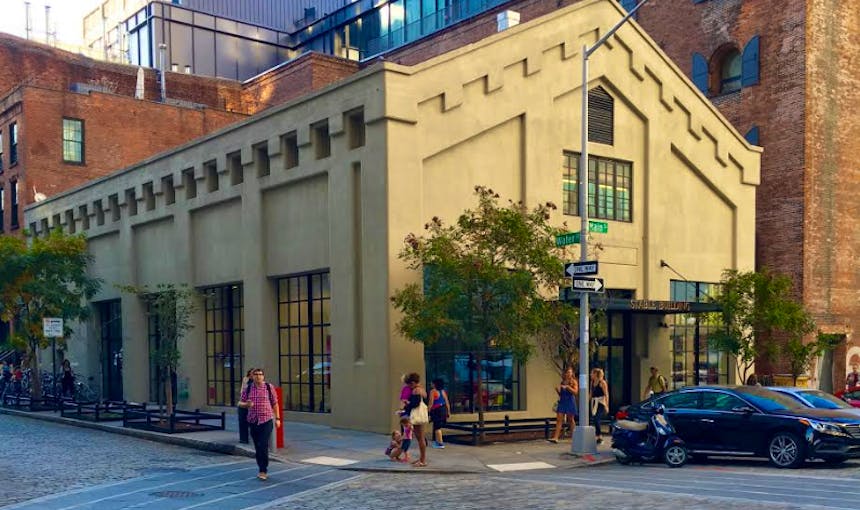
[11] 16 MAIN STREET – THE STABLE BUILDING
Year Built: 1906
Original owner: Robert Gair
Original purpose: Stable
Adaptive Reuse: Commercial, art galleries
16 Main Street was constructed in 1906 as a stable for the Gair company. While the stable has been repurposed over the years as autos and trucks took over from horses and carts, its wide entrance has remained and signified its past purpose. Today, 16 Main Street has made its name as the the hub for artists, hosting the art museum Galapagos from 2007-2014 and now housing four galleries – Janet Borden, Klompching, Minus Space and Higher Pictures Generation.

[12] 1 MAIN STREET, THE “CLOCKTOWER BUILDING”
Year built: 1914
Architect: William Higginson/Turner Construction Company, builder
Original owner: Robert Gair
Original purpose: Office and manufacturing space
Adaptive reuse: Condo Apartments
Structure/material: Reinforced concrete
This building’s story started when its owner Robert Gair, a genius in inventing machines to fold and manipulate paper, started to build his empire in Dumbo. With his invention of a machine for making corrugated cardboard and for folding boxes, Gair would take care of the packaging of all of the new products that were invented and manufactured in Brooklyn, the dreamland of the manufactured and packaged food industry at that time. The Gair firm soon became the largest manufacturer of boxes in the United States with many factories and offices in Dumbo. 1 Main Street was the most prominent of the Robert Gair Buildings and the tallest reinforced concrete building in the world when it was built in 1914. By the 1920s, the building was leased to the Charles William Stores, a mail-order business established by John Arbuckle, Gair’s friend and owner of Yuban coffee, another Dumbo-based company. Today, 1 Main Street symbolizes the area’s new prominence as a hip office-residential neighborhood.
Learn more about the history of 1 Main Street in this Brownstoner post.
The building under construction.
Photo via The Cement Era
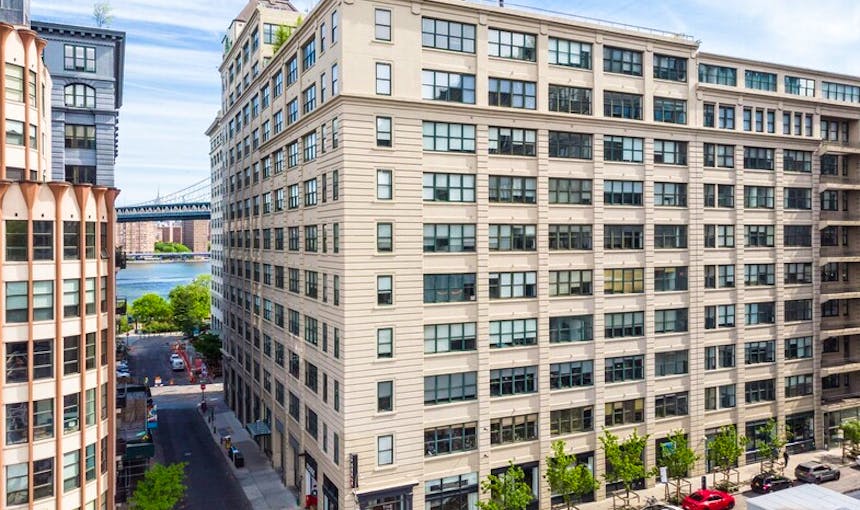
[13] 45 MAIN STREET
Year Built: 1919
Architect: William Higginson/Turner Construction Company, builder
Original owner: Robert Gair
Original Purpose: Factory
Adaptive Reuse: Commercial
45 Main Street was the third and final construction project on the block for industrialist and real estate developer Robert Gair. It is, therefore, a significant part of Dumbo’s “Gairville”. It is believed that Gair’s choice of the site was influenced by the previous move of his friend, coffee roaster John Arbuckle, to neighboring blocks. As with the other reinforced concrete buildings commissioned by Gair, this structure was designed by William Higginson and erected by the Turner Construction Company.
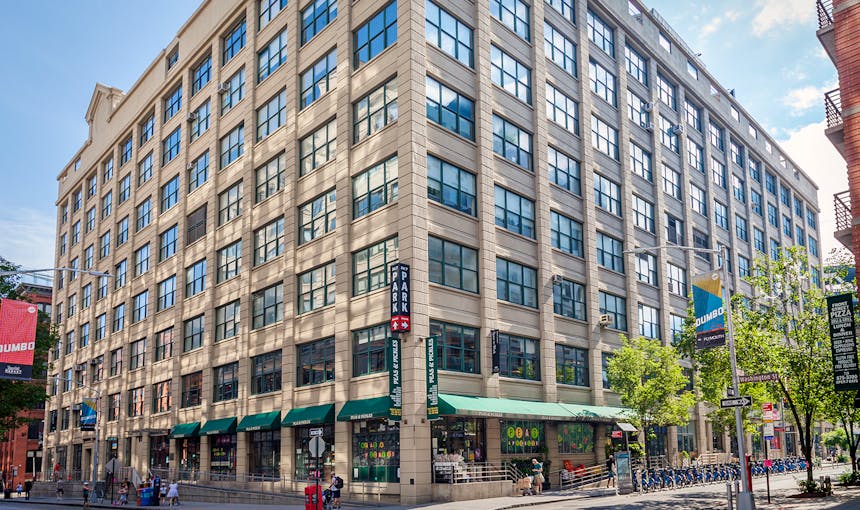
[15] 55 WASHINGTON STREET
Year Built: 1905
Architect: William Higginson/Turner Construction Company, builder
Original owner: Robert Gair
Original Purpose: Manufacture of cardboard with offices on the top floors
Adaptive Reuse: Office
Notable uses/Companies today: Etsy, Vice Media<
Material: Reinforced-concrete
55 Washington is a significant part of “Gairville,” the complex of factory structures erected in DUMBO by industrialist and real estate developer Robert Gair. This is the first reinforced concrete building for Gair and the largest of its kind at the time. Fire-proof and stable, concrete was useful in the business of manufacturing cardboard and print, but was still a new construction material. Legend has it that Gair and Turner lit a bonfire on the roof once the building was completed to prove that it was fire-proof.
Today, 55 Washington serves as the incubator space for e-commerce giant Etsy.
55 Washington Street.
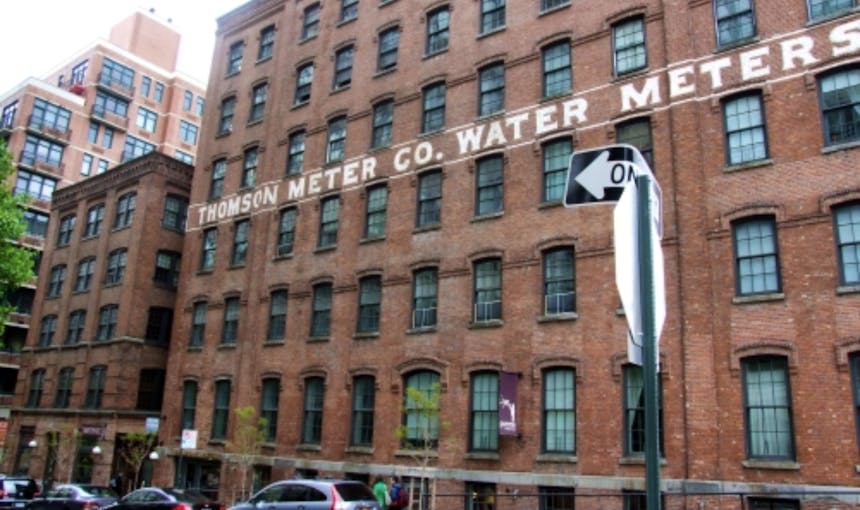
[16] 81-89 WASHINGTON STREET – THE THOMPSON WATER METER BUILDING
Year Built: 1882
Architect: Mercein Thomas
Original Owner: Ketchum & McDougall
Original Purpose: Factory
Adaptive reuse: Commercial and Residential
At 81-89 Washington Street, the bold signage on the Thompson Water Meter Building is a great example of signs that, although inaccurate, are nevertheless helpful in identifying and remembering buildings. 81-89 Washington Street was actually built for Ketchum & McDougall, a very successful jewelry company which spanned three adjoining factory buildings: 75 Washington Street, 81-89 Washington Street (this building), and 47-49 York Street, which is just around the corner. At some point, the Thompson Meter Company was one of the tenants but has never been the sole occupant or owner of the building. Even when John Thompson moved his Water Meter plant to Bridge Street in 1909, his name remained on the side of the building. Today, 81-89 Washington Street is converted into loft apartments and is part of the Walentas family’s Two Trees empire.

[17] 135 PLYMOUTH STREET
Year Built: 1900-1
Architect: Rudolphe L. Daus
Original Owner: E. W. Bliss
Original Purpose: Factory with drafting room on sixth story and offices on seventh story.
Adaptive reuse: Mixed-used
Notable uses/Companies today: Adams Street Library
The entire block bounded by Plymouth Street, Adams Street, John Street, and Pearl Street belonged to the E. W. Bliss Machinery Factory; the company also occupied buildings elsewhere in Dumbo (39-53 Jay Street, 202-206 Plymouth Street, and 208-214 Plymouth Street). Owned by machinist Eliphalet W. Bliss, the factories manufactured cans, other machinery, tools, dies and other cut and stamped metal products. This was among the largest operations in the Dumbo area, and by the beginning of the 20th century, employed over 1,600 people.
Today, it is home to the newly opened Adam Street Library, Brooklyn Public Library’s 60th and first new branch built since 1983, as well a loft apartments and other street level retail.
Learn more about the history of 135 Plymouth Street in this Brownstoner post.
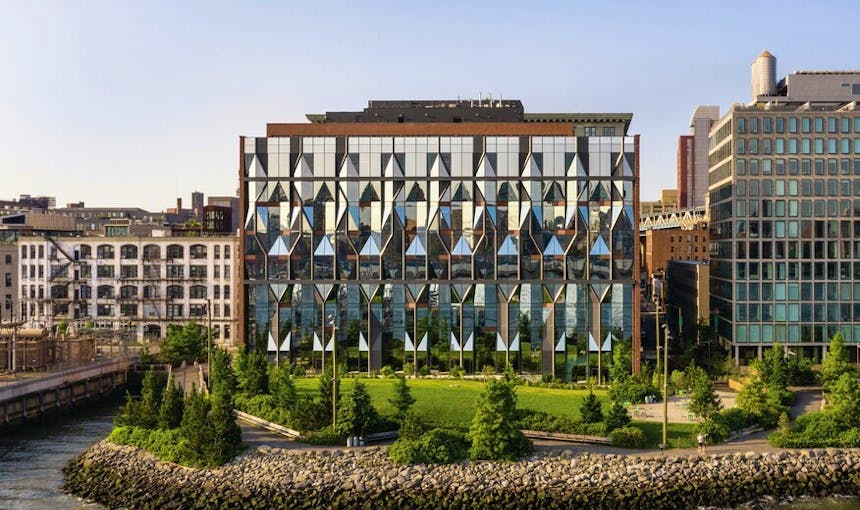
[20] 10 JAY STREET
Year Built: 1897-98
Architect: George M. Newhall Engineering Co.
Original Owner: Arbuckle Brothers
Original Purpose: Factory (sugar refinery)
Adaptive reuse: Commercial space
Like almost every other building in Dumbo that tells a great story of the development of the neighborhood, 10 Jay Street is the testimony of the “Great Coffee and Sugar War” between two Brooklyn-based empires: the Arbuckles, the King of Coffee and Henry O. Havemeyer, the King of Sugar. The war started when the Arbuckles were refused the discount for the sugar they needed for the roasting process. John Arbuckle then decided to refine his own sugar, which led to the construction of a series of adjoining refineries, with 10 Jay Street the main one. After the sugar production was ceased in 1945, 10 Jay Street was converted into a warehouse, and later, the river-facing façade of the building was removed. By the turn of the 21st century, this building enjoyed its revival as host of commercial tenants and creative businesses. A new river-facing façade was created, inspired by the building’s history as a sugar factory.
Historical drawing of the Arbuckle sugar refinery. (Courtesy ODA)
Learn more about the “Great Coffee and Sugar War” in this Brownstoner post.
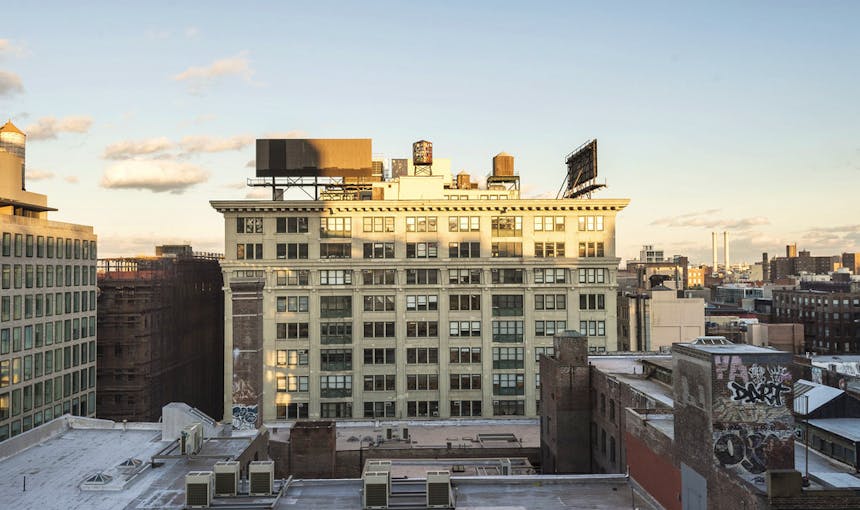
[21] 20 JAY STREET
Year Built: 1909
Architect: William Higginson
Original Owner: Arbuckle Brothers
Original Purpose: A warehouse and freight station with offices on the top floor
Adaptive reuse: warehouse and manufacturing, and now office
Material: reinforced-concrete
Like almost every other building in Dumbo that tells a great story of the development of the neighborhood, 20 Jay Street is the testimony of the “Great Coffee and Sugar War” between two Brooklyn-based empires: the Arbuckles, the King of Coffee and Henry O. Havemeyer, the King of Sugar. The war started when the Arbuckles was refused the discount for the sugar it needed for the roasting process. John Arbuckle then decided to refine his own sugar, which led to the construction of a series of adjoining refineries, with 20 Jay Street one of them. This building was connected to its neighbor, 10 Jay Street, through a bridge, which was removed when both refineries ceased production in 1945.
LEARN MORE ABOUT THE “GREAT COFFEE AND SUGAR WAR” IN THIS BROWNSTONER POST.

[23] 68 JAY STREET
Year Built: 1915
Architect: William Higginson
Original Owner: Jones Brothers
Original Purpose: Warehouse for tea
Adaptive reuse: Commercial use – retail and office spaces
Material: Brick; steel frame with reinforced concrete floors
This entire block, bounded by Pearl Street, Jay Street, Water Street, and Front Street, was occupied by the Grand Union Tea Company (also known as the Jones Brothers Tea Company), a huge grocery store chain. The 1904 edition of King’s Views of Brooklyn states that this was the “largest warehouse and factory in the United States for teas, coffees, spices, flavoring extracts, baking-powders and soaps.” Today, it is a hub of a remarkably diverse range of businesses, offices, artist’s spaces and showrooms.
Late-19th-century postcard on Etsy
Learn more about the history of Empire Stores in this Brownstoner post.
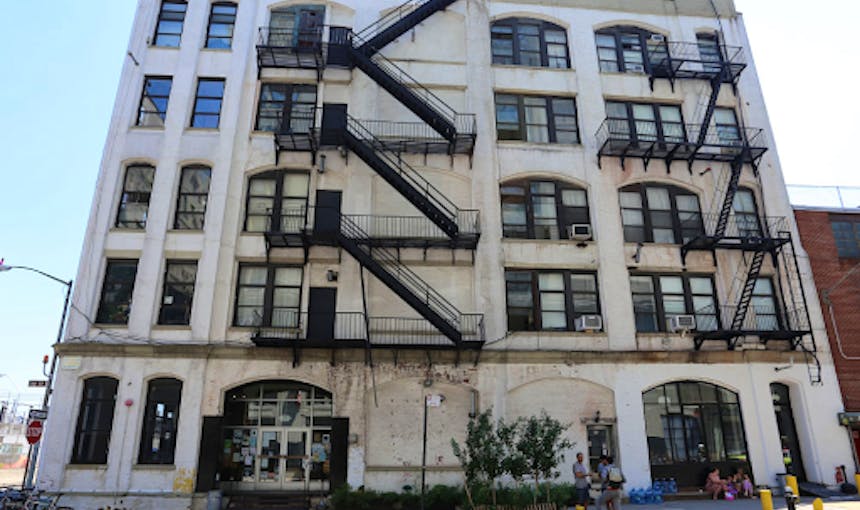
[24] 19-27 JAY STREET
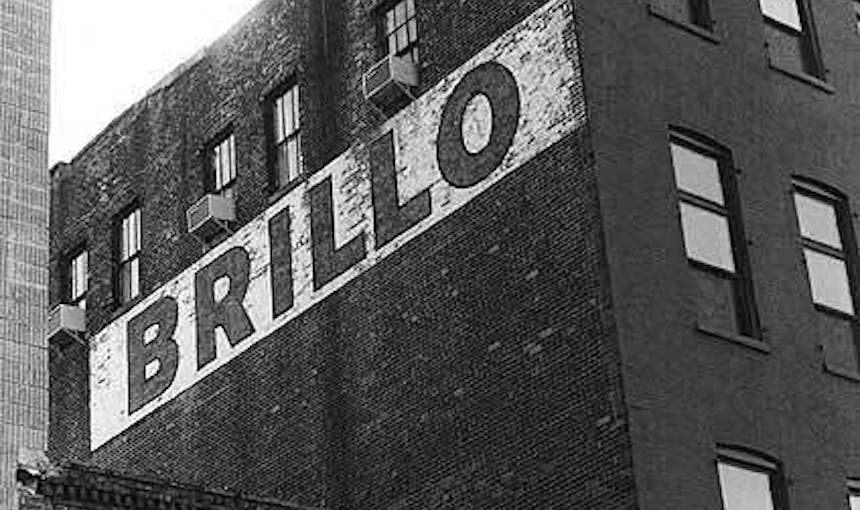
[25] 200 WATER STREET
Year Built: 1950
Architect: Sydney Goldstone; Turner Construction Company, builder
Original Owner: Brillo Company
Original Purpose: Factory
Adaptive reuse: Residential
This factory was built by the Brillo Company for the expansion of its Brooklyn plant at 188-200 Plymouth Street and 202-Plymouth Street, where the firm’s famous soap pads and industrial abrasives had been manufactured since 1925.

[27] 100-110 BRIDGE STREET
Year Built: 1908-09
Architect: Louis E. Jallade
Original Purpose: Factory
Original Owner: John Thompson
Adaptive reuse: Office and manufacture site of various small industries.
In 1887, John Thompson, a brilliant inventor who would hold over 350 patents during his lifetime, patented a device that accurately measured the amount of water coming into a building from public pipes. This device, named the Thompson water meter, was hailed as one of the most useful at the time, and became widespread in 1899 when New York city ordered water meters to be installed in every public building in the city. As demand for his product grew, John Thompson looked to expand his Water Meter plant, originally located at 81-89 Washington Street. This elegant terra-cotta ornamented factory building was the Thompson Water Meter plant’s new home. Designed by architect-engineer Louis Jallade, this building is a “pioneering example of an American building that employed a frank and “truthful” expression of exterior concrete that anticipated the later advocacy of European architects such as Le Corbusier, Walter Gropius, and Mies van der Rohe”.
After Thomson’s death, this building was sold to the New York Eskimo Pie Corp. for the regional manufacture of the first American chocolate-covered ice cream bar. Eskimo Pie products were made here for nearly 40 years. Learn more about the architecture of 28 Old Fulton in this Landmarks Preservation Commission document.



